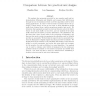Free Online Productivity Tools
i2Speak
i2Symbol
i2OCR
iTex2Img
iWeb2Print
iWeb2Shot
i2Type
iPdf2Split
iPdf2Merge
i2Bopomofo
i2Arabic
i2Style
i2Image
i2PDF
iLatex2Rtf
Sci2ools
ESORICS
2004
Springer
2004
Springer
Comparison Between Two Practical Mix Designs
We evaluate the anonymity provided by two popular email mix implementations, Mixmaster and Reliable, and compare their effectiveness through the use of simulations which model the algorithms used by these mixing applications. In order to draw accurate conclusions about the operation of these mixes, we use as our input to these simulations actual traffic data obtained from a public anonymous remailer (mix node). We determine that assumptions made in previous literature about the distribution of mix input traffic are incorrect, and our analysis of the input traffic shows that it follows no known distribution. We establish for the first time that a lower bound exists on the anonymity of Mixmaster, and discover that under certain circumstances the algorithm used by Reliable provides no anonymity. We find that the upper bound on anonymity provided by Mixmaster is slightly higher than that provided by Reliable. We identify flaws in the software code in Reliable that further compromise i...
| Added | 01 Jul 2010 |
| Updated | 01 Jul 2010 |
| Type | Conference |
| Year | 2004 |
| Where | ESORICS |
| Authors | Claudia Díaz, Len Sassaman, Evelyne Dewitte |
Comments (0)

